
Pimelea humilis, also known as common riceflower or dwarf riceflower, is a species of flowering plant in the family Thymelaeaceae and is endemic to south-eastern Australia. It is an erect or scrambling shrub with hairy stems, elliptic to lance-shaped leaves and heads of 12 to 52 of creamy-white, bisexual or female flowers.

Pimelea flava is a species of flowering plant in the family Thymelaeaceae and is endemic to south-eastern Australia. It is a shrub with narrowly elliptic to egg-shaped leaves arranged in opposite pairs, and compact clusters of 9 or more flowers with 2 or 4 elliptic to circular involucral bracts at the base. The flowers and bracts are white or yellow, depending on subspecies.

Pimelea octophylla, commonly known as woolly riceflower or downy riceflower, is a species of flowering plant in the family Thymelaeaceae and is endemic to south-eastern continental Australia. It is an erect shrub with densely hairy young stems, narrowly elliptic leaves and heads of 22 to 45 densely hairy, cream-coloured to pale yellow flowers surrounded by 6 to 12 leaf-like involucral bracts.

Pimelea spinescens, commonly known as plains rice-flower, spiny rice-flower or prickly pimelea, is a species of flowering plant in the family Thymelaeaceae and is endemic to Victoria. It is a spreading undershrub with elliptic leaves arranged in opposite pairs, and heads of white, cream-coloured or yellow flowers surrounded by 4 elliptic, leaf-like involucral bracts.

Pimelea serpyllifolia, commonly known as thyme riceflower, is a species of flowering plant in the family Thymelaeaceae and is endemic to southern Australia. It is an erect shrub with narrowly elliptic to spatula-shaped leaves, and compact heads of 4 to 12 yellow, yellowish-green or white flowers surrounded by 2 or 4 leaf-like involucral bracts. Male and female flowers are borne on separate plants.

Pimelea ligustrina is a species of flowering plant in the family Thymelaeaceae, and is endemic to south-eastern Australia. It is a shrub with lance-shaped or narrowly elliptic leaves arranged in opposite pairs, and clusters of creamy-white, white or pinkish flowers usually surrounded by 4 or 8, greenish to reddish brown involucral bracts.
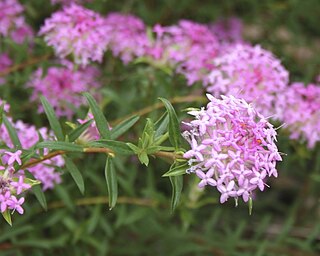
Pimelea rosea, commonly known as rose banjine, is a species of flowering plant in the family Thymelaeaceae and is endemic to the south-west of Western Australia. It is an erect shrub with narrowly elliptic leaves, and clusters of pale pink to reddish-purple flowers surrounded by 4 egg-shaped involucral bracts.
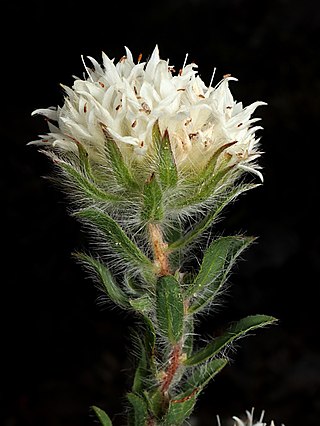
Pimelea imbricata is a species of flowering plant in the family Thymelaeaceae and is native to the southwest of Western Australia and south-eastern South Australia. It is a shrub with narrowly elliptic leaves and erect, compact clusters of white or pink flowers surrounded by 10 to 22 green or red to purple involucral bracts.
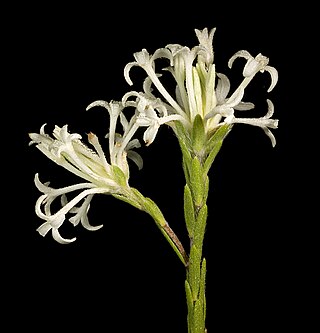
Pimelea longiflora is a species of flowering plant in the family Thymelaeaceae and is endemic to the southwest of Western Australia. It is an erect, spindly shrub with linear to narrowly elliptic leaves and erect clusters of white to cream-coloured flowers, surrounded by 4 to 6 green, egg-shaped involucral bracts.
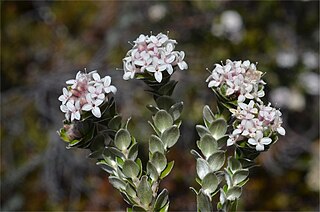
Pimelea sericea is a species of flowering plant in the family Thymelaeaceae and is endemic to Tasmania. It is a shrub with densely hairy young stems, elliptic leaves arranged in opposite pairs, and compact clusters of white, pink or pinkish-white flowers.
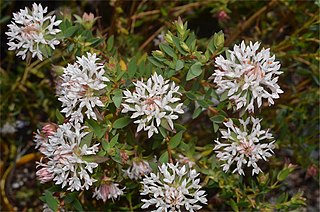
Pimelea sylvestris is a species of flowering plant in the family Thymelaeaceae and is endemic to the south-west of Western Australia. It is an erect shrub with narrowly elliptic to elliptic leaves arranged in opposite pairs, and compact heads of white or pink flowers surrounded by 2 or 4 pairs of narrowly egg-shaped involucral bracts.
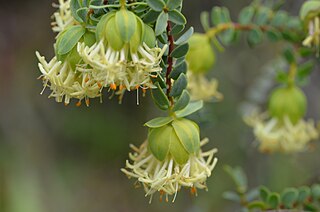
Pimelea sulphurea, commonly known as yellow banjine, is a species of flowering plant in the family Thymelaeaceae and is endemic to the south-west of Western Australia. It is an erect, spindly or open shrub with narrowly elliptic to more or less round leaves, and compact heads of pendulous, yellow flowers surrounded by 3 or more pairs of green to yellowish involucral bracts.

Pimelea curviflora, also known as curved rice-flower, is a shrub in the family Thymelaeaceae and is endemic to Australia. It is a small, hairy shrub with greenish-yellow or red tubular flowers.

Pimelea argentea, commonly known as silvery leaved pimelea, is a species of flowering plant in the family Thymelaeaceae and is endemic to the south-west of Western Australia. It is an erect shrub with densely hairy young stems and leaves, the leaves linear to elliptic, and heads of white to yellow or greenish flowers, the male and female flowers on separate plants.
Pimelea brevifolia is a species of flowering plant in the family Thymelaeaceae and is endemic to the south-west of Western Australia. It is an undershrub or shrub with erect, elliptic leaves, and heads of white flowers surrounded by four involucral bracts.

Pimelea cracens is a species of flowering plant in the family Thymelaeaceae and is endemic to the southwest of Western Australia. It is an erect, spindly shrub with narrowly elliptic to egg-shaped leaves and creamy green to pale yellow flowers surrounded by 6 or 8 yellowish or pale green and reddish involucral bracts.

Pimelea latifolia is a species of flowering plant in the family Thymelaeaceae and is endemic to eastern Australia. It is a shrub with hairy young stems, egg-shaped leaves with the narrower end towards the base, and greenish-yellow to white, tube-shaped flowers.

Pimelea lehmanniana is a species of flowering plant in the family Thymelaeaceae and is endemic to the southwest of Western Australia. It is a shrub with narrowly egg-shaped leaves and clusters of white to pale yellow flowers surrounded by 4 or 6, pale yellowish-green involucral bracts.

Pimelea simplex, commonly known as desert rice-flower, is a species of flowering plant in the family Thymelaeaceae and is endemic to inland Australia. It is a herb or semi-woody annual with narrowly elliptic to linear leaves, and compact heads of densely hairy white to yellowish-green flowers.

Pimelea spiculigera is a species of flowering plant in the family Thymelaeaceae and is endemic to Western Australia. It is an erect shrub with linear to narrowly egg-shaped leaves and heads of yellow or greenish-yellow flowers surrounded by 2 or 4 egg-shaped involucral bracts.





















